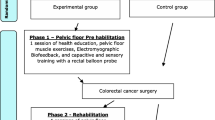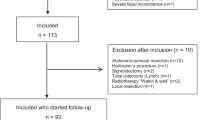Abstract
Background
The aim of this study was to evaluate the effectiveness of pelvic floor rehabilitation (PFR) for patients with bowel dysfunction after intersphincteric resection (ISR) and to compare the treatment response to that of patients after low anterior resection (LAR).
Methods
Thirty patients with postoperative bowel dysfunction for more than 6 months were enrolled and treated with PFR for 6 months.
Results
In the ISR group, significant improvements in the number of bowel movements and the use of antidiarrheal medications were observed, but no significant improvement was observed in the Wexner score (WS) and the fecal incontinence severity index (FISI). Meanwhile, in the LAR group, WS and FISI were better post-treatment than pre-treatment (WS: 10.7–5.7; p = 0.01, FISI: 28–11; p = 0.01). In the assessment of fecal incontinence quality of life (FIQL), only the Coping/Behavior category was improved in the ISR group (1.56 before, 2.16 after PFR; p = 0.01), while all four categories were improved significantly in the LAR group. The anorectal manometric examination showed no significant increase in sphincter pressure and the tolerable volume in patients after ISR.
Conclusions
PFR improved several clinical symptoms of patients after ISR. Compared with patients after LAR, patients after ISR showed an insufficient response to PFR in improving fecal incontinence. Considering the result of the generalized assessment of the quality of life scale, PFR may offer a therapeutic effect for several symptoms of patients after ISR.



Similar content being viewed by others
References
Schiessel R, Karner-Hanusch J, Herbst F et al (1994) Intersphincteric resection for low rectal tumours. Br J Surg 81:1376–1378
Saito N, Ito M, Kobayashi A et al (2014) Long-term outcomes after intersphincteric resection for low-lying rectal cancer. Ann Surg Oncol 21:3608–3615
Han F, Li H, Zheng D et al (2010) A new sphincter-preserving operation for low rectal cancer: ultralow anterior resection and colorectal/coloanal anastomosis by supporting bundling-up method. Int J Colorectal Dis 25:873–880
Park JS, Choi GS, Jun SH et al (2011) Laparoscopic versus open intersphincteric resection and coloanal anastomosis for low rectal cancer: intermediate-term oncologic outcomes. Ann Surg 254:941–946
Maris A, Devreese AM, D’Hoore A et al (2013) Treatment options to improve anorectal function following rectal resection: a systematic review. Colorectal Dis 15:e67–e78
Pucciani F, Ringressi MN, Redditi S et al (2008) Rehabilitation of fecal incontinence after sphincter-saving surgery for rectal cancer: encouraging results. Dis Colon Rectum 51:1552–1558
Kim KH, Yu CS, Yoon YS et al (2011) Effectiveness of biofeedback therapy in the treatment of anterior resection syndrome after rectal cancer surgery. Dis Colon Rectum 54:1107–1113
Juul T, Ahlberg M, Biondo S et al (2014) Low anterior resection syndrome and quality of life: an international multicenter study. Dis Colon Rectum 57:585–591
Ho YH, Tan M (1997) Biofeedback therapy for bowel dysfunction following low anterior resection. Ann Acad Med Singapore 26:299–302
Bretagnol F, Rullier E, Laurent C et al (2004) Comparison of functional results and quality of life between intersphincteric resection and conventional coloanal anastomosis for low rectal cancer. Dis Colon Rectum 47:832–838
Ito M, Saito N, Sugito M et al (2009) Analysis of clinical factors associated with anal function after intersphincteric resection for very low rectal cancer. Dis Colon Rectum 52:64–70
Nishizawa Y, Saito N, Fujii S et al (2012) Association between anal function and therapeutic effect after preoperative chemoradiotherapy followed by intersphincteric resection. Dig Surg 29:439–445
Rullier E, Zerbib F, Laurent C et al (1999) Intersphincteric resection with excision of internal anal sphincter for conservative treatment of very low rectal cancer. Dis Colon Rectum 42:1168–1175
Ho YH, Low D, Goh HS (1996) Bowel function survey after segmental colorectal resections. Dis Colon Rectum 39:307–310
Dulskas A, Samalavicius NE (2016) Usefulness of anorectal manometry for diagnosing continence problems after a low anterior resection. Ann Coloproctol 32:101–104
O’Riordain MG, Molloy RG, Gillen P et al (1992) Rectoanal inhibitory reflex following low stapled anterior resection of the rectum. Dis Colon Rectum 35:874–878
Chiang JM, Yeh CY, Wang JY (1997) Anorectal manometric characteristics differ in biofeedback for postoperative fecal incontinence. J Surg Assoc Repub China 30:316–321
van Duijvendijk P, Slors JF, Taat CW et al (2002) Prospective evaluation of anorectal function after total mesorectal excision for rectal carcinoma with or without preoperative radiotherapy. Am J Gastroenterol 97:2282–2289
Allgayer H, Dietrich CF, Rohde W et al (2005) Prospective comparison of short- and long-term effects of pelvic floor exercise/biofeedback training in patients with fecal incontinence after surgery plus irradiation versus surgery alone for colorectal cancer: clinical, functional and endoscopic/endosonographic findings. Scand J Gastroenterol 40:1168–1175
Laforest A, Bretagnol F, Mouazan AS et al (2012) Functional disorders after rectal cancer resection: does a rehabilitation programme improve anal continence and quality of life? Colorectal Dis 14:1231–1237
Author information
Authors and Affiliations
Corresponding author
Ethics declarations
Conflict of interest
None of the authors has any conflicts of interest to disclose regarding the work in this manuscript.
Rights and permissions
About this article
Cite this article
Nishigori, H., Ishii, M., Kokado, Y. et al. Effectiveness of Pelvic Floor Rehabilitation for Bowel Dysfunction After Intersphincteric Resection for Lower Rectal Cancer. World J Surg 42, 3415–3421 (2018). https://doi.org/10.1007/s00268-018-4596-8
Published:
Issue Date:
DOI: https://doi.org/10.1007/s00268-018-4596-8




